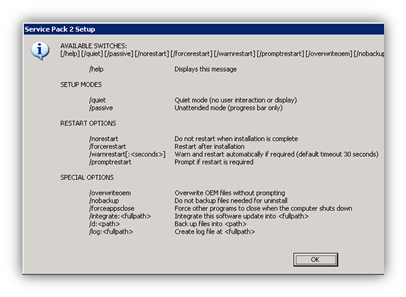Install Windows Service Pack on a VM
On a newly installed Virtual Machine you don’t need any uninstall information from a servicepack, which consumes lots of diskspace. You can install the SP2 for Windows Server 2003 (R2) with the /nobackup parameter.

RESTART OPTIONS
/NORESTART:
No restart will take place. You will have to perform a manual restart yourself before the service pack installation can be considered complete.
/FORCERESTART:
A restart will automatically take place at the end of the installation.This will be handy if you automate the execution of UPDATE.EXE.
/WARNRESTART:
You can pop up a dialog to let people know that a restart will take place in X seconds.
/PROMPTRESTART: A request to initiate a restart will be displayed for the interactive user/administrator to acknowledge.
SPECIAL OPTIONS
/OVERWRITEOEM:
Microsoft includes updated versions of some drivers in the service pack. If the installation finds a driver on your system that it wants to update, it will usually ask if you want to go ahead with this upgrade. Using this flag will force the installer to automatically do this for you. Personally, and I think others agree, if HP, IBM, Dell, etc, have provided me with a driver then I’m going to suspect that there’s something special about it. In fact, these manufacturers often do provide customised or
tweaked versions of drivers from mass manufactures such as Intel or Broadcom. I wouldn’t want to go messing with those drivers, especially if I’m using an OEM version control system for them or an SMS Inventory Tool from the likes of HP or Dell.
/NOBACKUP:
Normally, the service pack will create the familiar uninstall folder in the Windows folder. Along with this, a new item is added to the Add/Remove Programs applet in Control Panel. This enables an administrator to roll back the service pack installation if something breaks. Unfortunately, I’ve come across several sites where for some unknown reason, administrators choose to make the C: drive for fresh Windows 2003 installations as small as possible, often less than 5GB. The partition quickly fills up once the OS is installed; quickly followed by anti-virus, backup agents, page file, etc. In this case it may be prudent not to create a backup folder. This means that the service pack can never be uninstalled … so testing and application certification become even more critical.
/d:
We’ve just seen how we can choose not to backup files into the Windows folder because C: is nearly full. If you have space elsewhere, you can use the /d flag to point to that path to backup the
